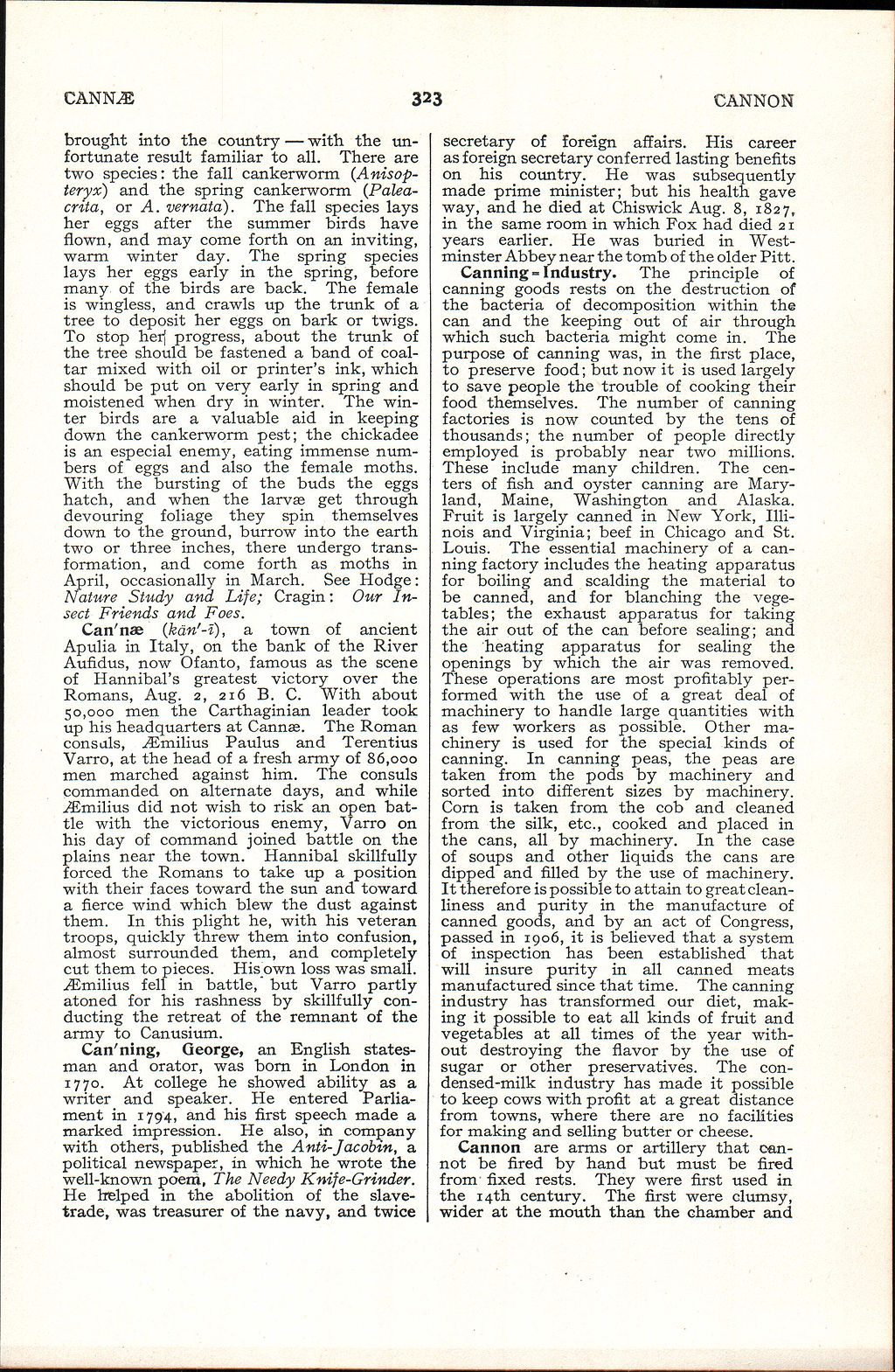CANNJE
323
CANNOH
brought into the country — with the unfortunate result familiar to all. There are two species: the fall cankerworm (Anisop-teryx) and the spring cankerworm (Palea-crita, or A. vernata). The fall species lays her eggs after the summer birds have flown, and may come forth on an inviting, warm winter day. The spring species lays her eggs early in the spring, before many of the birds are back. The female is wingless, and crawls up the trunk of a tree to deposit her eggs on bark or twigs. To stop herj progress, about the trunk of the tree should be fastened a band of coal-tar mixed with oil or printer's ink, which should be put on very early in spring and moistened when dry in winter. The winter birds are a valuable aid in keeping down the cankerworm pest; the chickadee is an especial enemy, eating immense numbers of eggs and also the female moths. With the bursting of the buds the eggs hatch, and when the larvae get through devouring foliage they spin themselves down to the ground, burrow into the earth two or three inches, there undergo transformation, and come forth as moths in April, occasionally in March. See Hodge: Nature Study and Life; Cragin: Our Insect Friends and Foes.
Can/nae (kanf-i}, a town of ancient Apulia in Italy, on the bank of the River Aufidus, now Ofanto, famous as the scene of Hannibal's greatest victory over the Romans, Aug. 2, 216 B. C. With about 50,000 men the Carthaginian leader took up his headquarters at Cannae. The Roman cons als, ^Emilius Paulus and Terentius Varro, at the head of a fresh army of 86,000 men marched against him. The consuls commanded on alternate days, and while ^Emilius did not wish to risk an open battle with the victorious enemy, Varro on his day of command joined battle on the plains near the town. Hannibal skillfully forced the Romans to take up a position with their faces toward the sun and toward a fierce wind which blew the dust against them. In this plight he, with his veteran troops, quickly threw them into confusion, almost surrounded them, and completely cut them to pieces. Hispwn loss was small. ^Emilius fell in battle, but Varro partly atoned for his rashness by skillfully conducting the retreat of the remnant of the army to Canusium.
Can'ning, George, an English statesman and orator, was born in London in 1770. At college he showed ability as a writer and speaker. He entered Parliament in 1794, and his first speech made a marked impression. He also, in company with others, published the Anti-Jacobin, a political newspaper, in which he wrote the well-known poem, The Needy Knife-Grinder. He helped in the abolition of the slave-trade, was treasurer of the navy, and twice
secretary of foreign affairs. His career as foreign secretary conferred lasting benefits on his country. He was subsequently made prime minister; but his health gave way, and he died at Chiswick Aug. 8, 1827, in the same room in which Fox had died 21 years earlier. He was buried in Westminster Abbey near the tomb of the older Pitt.
Canning-Industry. The principle of canning goods rests on the destruction of the bacteria of decomposition within the can and the keeping put of air through which such bacteria might come in. The purpose of canning was, in the first place, to preserve food; but now it is used largely to save people the trouble of cooking their food themselves. The number of canning factories is now counted by the tens of thousands; the number of people directly employed is probably near two millions. These include many children. The centers of fish and oyster canning are Maryland, Maine, Washington and Alaska. Fruit is largely canned in New York, Illinois and Virginia; beef in Chicago and St. Louis. The essential machinery of a canning factory includes the heating apparatus for boiling and scalding the material to be canned, and for blanching the vegetables; the exhaust apparatus for taking the air out of the can before sealing; and the heating apparatus for sealing the openings by which the air was removed. These operations are most profitably performed with the use of a great deal of machinery to handle large quantities with as few workers as possible. Other machinery is used for the special kinds of canning. In canning peas, the peas are taken from the pods by machinery and sorted into different sizes by machinery. Corn is taken from the cob and cleaned from the silk, etc., cooked and placed in the cans, all by machinery. In the case of soups and other liquids the cans are dipped and filled by the use of machinery. It therefore is possible to attain to great cleanliness and purity in the manufacture of canned goods, and by an act of Congress, passed in 1906, it is believed that a system of inspection has been established that will insure purity in all canned meats manufactured since that time. The canning industry has transformed our diet, making it possible to eat all kinds of fruit and vegetables at all times of the year without destroying the flavor by the use of sugar or other preservatives. The condensed-milk industry has made it possible to keep cows with profit at a great distance from towns, where there are no facilities for making and selling butter or cheese.
Cannon are arms or artillery that cannot be fired by hand but must be fired from fixed rests. They were first used in the 14th century. The first were clumsy, wider at the mouth than the chamber and
